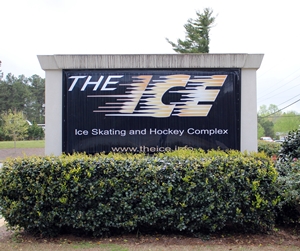 When you think hockey, naturally you think Atlanta, right? No? Well maybe if the object in hockey was to see who could skate around the rink counterclockwise as fast as possible? And what if players scored bonus points for crashing into other players and taking them out of the game? If that were the case, maybe the Flames or Thrashers would still be playing in Atlanta. But hey, no one in Calgary or Winnipeg is complaining. Sorry, I digress. Let me get straight to the good stuff. Here are the best things about our camp in Atlanta:
When you think hockey, naturally you think Atlanta, right? No? Well maybe if the object in hockey was to see who could skate around the rink counterclockwise as fast as possible? And what if players scored bonus points for crashing into other players and taking them out of the game? If that were the case, maybe the Flames or Thrashers would still be playing in Atlanta. But hey, no one in Calgary or Winnipeg is complaining. Sorry, I digress. Let me get straight to the good stuff. Here are the best things about our camp in Atlanta:
- Great Facility – Super clean with outstanding ice conditions
- Locker Rooms to keep our gear in all weekend!
- High quality, yet inexpensive lodging
- Our only location in the Southeast
- Lots of reps and individual attention!
That last one is a big deal. This camp tends to be “lightly attended” by skaters (although it usually sells out to goalies). We typically only get 20 or so skaters. That’s not so great for us, but is awesome for you. So if you are looking for a camp where you are going to get extra personal attention from coaches, as well as a ton of reps through every drill, then Atlanta is an outstanding choice. Just beware, you are likely going to be very tired and sore by Sunday!
Our social events are a big part of the experience, and aid in developing friendships and camaraderie among all of the players and coaches. After our Thursday evening skate we head to The Castlebury Ale House. Weather permitting, we post up out on the patio where we order ice cold buckets of beer for our thirsty gang, and put the NHL playoffs up on the big outdoor projector screen. On Friday night we find a sports bar with lots of TV’s to enjoy each other’s company and the various NHL playoff games. The Saturday evening camp banquet is held at Provino’s Italian Restaurant, where they always provide us with an outstanding meal, while we celebrate the accomplishments and laugh about the shenanigans of the weekend.
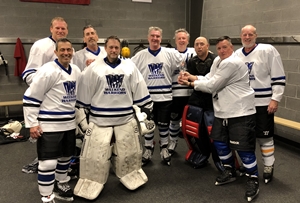 Speaking of shenanigans, the Atlanta camp is the home of the Stella Cup, a third cousin twice removed of the slightly more famous, but no more prestigious Stanley Cup. I’m not quite sure how it started, but I suspect it was one of the players who “accidentally” left one of our social events with a Stella beer glass. As the weekend rivalry between the White and Blue squads heated up, it was determined that the Sunday scrimmage would have to settle the score, with the victor being awarded the Stella Cup. That was a few years ago, and it’s now an annual tradition. The White team won it last year, as is evidenced by the photo at right. I’m confident that each player has had his cherished day with the cup over the past year, and it will soon make it’s way back to Atlanta (handled appropriately with white gloves, of course) to be awarded once again this year!
Speaking of shenanigans, the Atlanta camp is the home of the Stella Cup, a third cousin twice removed of the slightly more famous, but no more prestigious Stanley Cup. I’m not quite sure how it started, but I suspect it was one of the players who “accidentally” left one of our social events with a Stella beer glass. As the weekend rivalry between the White and Blue squads heated up, it was determined that the Sunday scrimmage would have to settle the score, with the victor being awarded the Stella Cup. That was a few years ago, and it’s now an annual tradition. The White team won it last year, as is evidenced by the photo at right. I’m confident that each player has had his cherished day with the cup over the past year, and it will soon make it’s way back to Atlanta (handled appropriately with white gloves, of course) to be awarded once again this year!
Our hotel is the Holiday Inn Express & Suites Alpharetta Windward Parkway, where they promise they will check you in before you can say the full property name three times. It’s a really sweet property. Since it’s a business area and we are there on the weekend, we get a killer rate. And it includes their hot breakfast buffet to get you fueled up for the morning skate.
This camp draws players from all over the Southeast and beyond. In fact, there are always more players there from surrounding states than there are from the Atlanta area. We typically have significant contingents from Florida, North and South Carolina, Alabama and more. If you can make it to Atlanta, you’ll have a great time, and with a lighter turnout, you’ll experience a Weekend Warriors camp turned up to 11! I hope you’ll join us April 30-May 3, 2020 at our Atlanta Camp!
Below are some photos from our Atlanta camp.

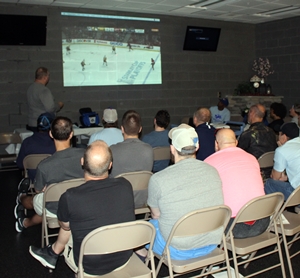
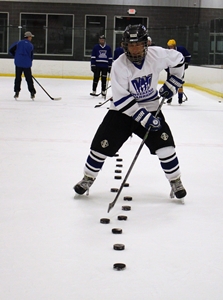
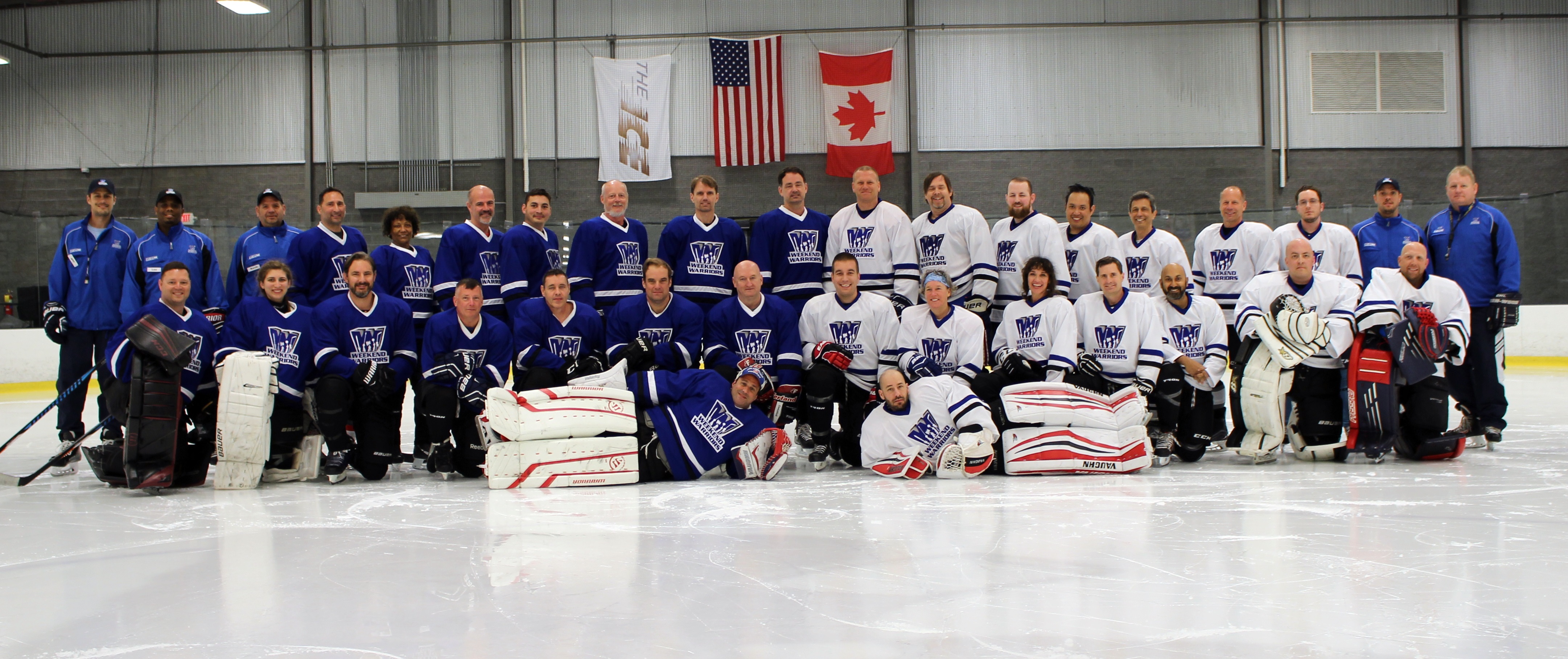

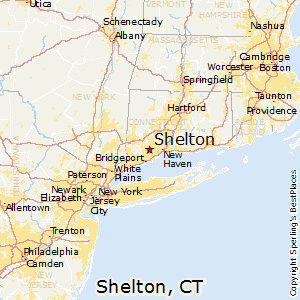 Where is Shelton, Connecticut? What made you decide to do a camp there? Why Shelton? These are common questions I get regarding this camp in a small town that most people have never heard of. So let’s start with the where. Shelton is located in southwestern Connecticut, approximately halfway between New York City and Hartford. If you’re flying in, it’s just a little over an hour from LaGuardia or JFK airports, and there is a shuttle that will take you from either airport to our hotel for about $70 each way. You don’t even need to rent a car. As far as what made us decide to do a camp in this town, it’s really quite simple… they asked. One day back in 2012 I received a call from the rink manager. She had heard of our program, and said she was very interested in having us come to The Rinks at Shelton. The rest is history. We have been coming back every year since. The rink staff is so friendly and accommodating. This not only makes my life easier, but it makes your experience as a player that much better. It’s the little things they do. First and foremost, they provide a large locker room where we can dress and store gear in all
Where is Shelton, Connecticut? What made you decide to do a camp there? Why Shelton? These are common questions I get regarding this camp in a small town that most people have never heard of. So let’s start with the where. Shelton is located in southwestern Connecticut, approximately halfway between New York City and Hartford. If you’re flying in, it’s just a little over an hour from LaGuardia or JFK airports, and there is a shuttle that will take you from either airport to our hotel for about $70 each way. You don’t even need to rent a car. As far as what made us decide to do a camp in this town, it’s really quite simple… they asked. One day back in 2012 I received a call from the rink manager. She had heard of our program, and said she was very interested in having us come to The Rinks at Shelton. The rest is history. We have been coming back every year since. The rink staff is so friendly and accommodating. This not only makes my life easier, but it makes your experience as a player that much better. It’s the little things they do. First and foremost, they provide a large locker room where we can dress and store gear in all 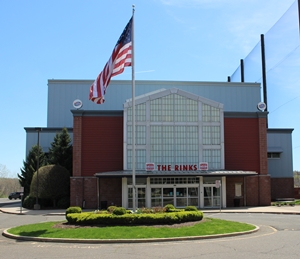 weekend. That’s awesome, as it means no lugging gear to and from the rink. And no keeping your gear in your hotel room! We also get a very nice, spacious meeting room for all of our off ice activities. Further, when nobody is on the ice after us, we can extend our session for those that want to spend a little more time practicing the skills they just learned. By the way, it’s a very unique rink in that it’s a double decker, with one sheet on the ground floor, and another directly above it. Pretty cool!
weekend. That’s awesome, as it means no lugging gear to and from the rink. And no keeping your gear in your hotel room! We also get a very nice, spacious meeting room for all of our off ice activities. Further, when nobody is on the ice after us, we can extend our session for those that want to spend a little more time practicing the skills they just learned. By the way, it’s a very unique rink in that it’s a double decker, with one sheet on the ground floor, and another directly above it. Pretty cool!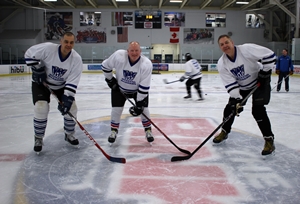


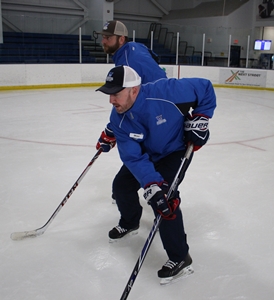
 Our camp in Pittsburgh is the first on our schedule, and as such, provides us with some added fun and excitement, as my staff and I are always pumped for the first camp of the year. The NHL playoffs are just underway at this point which means that there are multiple playoff games on TV each night. It is hard not to enjoy the playoff atmosphere, especially given that the Penguins are perennial playoff participants (say that 3 times fast).
Our camp in Pittsburgh is the first on our schedule, and as such, provides us with some added fun and excitement, as my staff and I are always pumped for the first camp of the year. The NHL playoffs are just underway at this point which means that there are multiple playoff games on TV each night. It is hard not to enjoy the playoff atmosphere, especially given that the Penguins are perennial playoff participants (say that 3 times fast).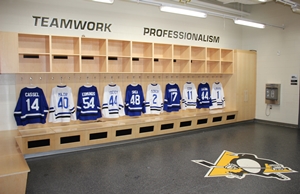 takes great care of us. Our off ice video review and chalk talks take place in the same room as the Penguins’ press conferences. And the rink lets us use the “Penguins’ Elite Locker Room” (pictured here) for the entire weekend. No, this is not the locker room that the Penguins use, but it’s probably nicer than any locker room you’ve dressed in before. And since we get to keep it all weekend, there is no need to lug your gear home, or worse yet, have to dry it in your hotel room. The rink also has really good food. And no, I’m not talking about nachos and “roller dogs”. The menu at this place is created by the Penguins’ chef, and is simultaneously healthy, delicious and affordable.
takes great care of us. Our off ice video review and chalk talks take place in the same room as the Penguins’ press conferences. And the rink lets us use the “Penguins’ Elite Locker Room” (pictured here) for the entire weekend. No, this is not the locker room that the Penguins use, but it’s probably nicer than any locker room you’ve dressed in before. And since we get to keep it all weekend, there is no need to lug your gear home, or worse yet, have to dry it in your hotel room. The rink also has really good food. And no, I’m not talking about nachos and “roller dogs”. The menu at this place is created by the Penguins’ chef, and is simultaneously healthy, delicious and affordable.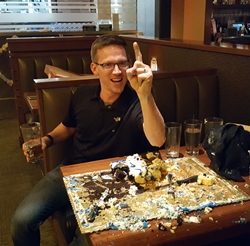 Our Thursday evening “Break the Ice” social takes place at the Sports Grille Cranberry. It’s a great place to grab a bite and a beer after the first ice session, socialize with the coaches and other campers, and take in all the playoff games on their multitude of TVs. On Friday night we usually pick another nearby watering hole for an informal gathering where we have some dinner and a beer or three, while watching playoff hockey, talking hockey and just generally being immersed in…you guessed it, hockey! Then on Saturday night we have our camp banquet at Houlihan’s, where we enjoy a tasty meal, the wonderful company of our new found hockey friends, and just have a general good time. Last year we were treated to one of the funniest things I’ve ever seen, as one of our Warriors took down an unsuspecting waiter in a cake eating contest. Exactly what was that young waiter thinking when he dared to take on one of our Warriors?!
Our Thursday evening “Break the Ice” social takes place at the Sports Grille Cranberry. It’s a great place to grab a bite and a beer after the first ice session, socialize with the coaches and other campers, and take in all the playoff games on their multitude of TVs. On Friday night we usually pick another nearby watering hole for an informal gathering where we have some dinner and a beer or three, while watching playoff hockey, talking hockey and just generally being immersed in…you guessed it, hockey! Then on Saturday night we have our camp banquet at Houlihan’s, where we enjoy a tasty meal, the wonderful company of our new found hockey friends, and just have a general good time. Last year we were treated to one of the funniest things I’ve ever seen, as one of our Warriors took down an unsuspecting waiter in a cake eating contest. Exactly what was that young waiter thinking when he dared to take on one of our Warriors?!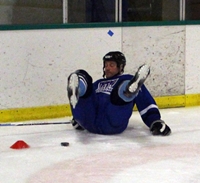
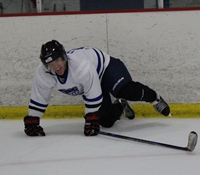
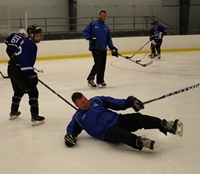
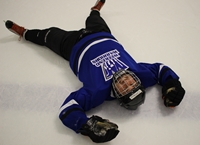
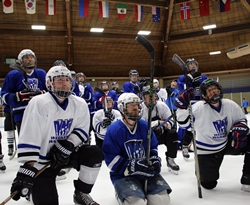
 3) Camaraderie – “Camaraderie, Shamaraderie…That’s a bunch of BS. I’m just here for the drills.”, you say. Well I could not disagree more. While the learning experience is the most compelling reason to attend hockey camp, do not underestimate the power of the people. And as people, hockey players, particularly Weekend Warriors, are some of the best on this planet. We have a passion for this game, and when we get together to learn, play and talk about this game, there is a special energy that is pretty hard to duplicate. Players come to camp and forge friendships with fellow payers, coaches and yours truly…friendships that will last for many years to come, if not a lifetime. In my opinion, the camaraderie is the “special sauce” that makes the experience so memorable.
3) Camaraderie – “Camaraderie, Shamaraderie…That’s a bunch of BS. I’m just here for the drills.”, you say. Well I could not disagree more. While the learning experience is the most compelling reason to attend hockey camp, do not underestimate the power of the people. And as people, hockey players, particularly Weekend Warriors, are some of the best on this planet. We have a passion for this game, and when we get together to learn, play and talk about this game, there is a special energy that is pretty hard to duplicate. Players come to camp and forge friendships with fellow payers, coaches and yours truly…friendships that will last for many years to come, if not a lifetime. In my opinion, the camaraderie is the “special sauce” that makes the experience so memorable.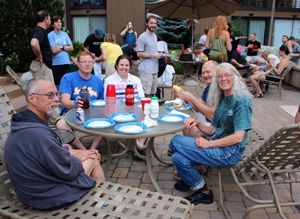 4) It’s a Vacation – Make no mistake, you’re not going to be lying on the beach getting a tan (except maybe in Tahoe). You’re going away to play a sport you love, and learn to play it better. It’s hard work. When you get back, your body might not feel like it was on vacation, but your mind and spirit will be recharged after such an exhilarating experience.
4) It’s a Vacation – Make no mistake, you’re not going to be lying on the beach getting a tan (except maybe in Tahoe). You’re going away to play a sport you love, and learn to play it better. It’s hard work. When you get back, your body might not feel like it was on vacation, but your mind and spirit will be recharged after such an exhilarating experience.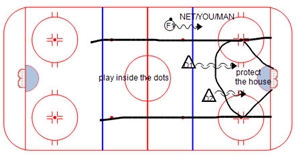 1) Defend the “Guts of the Ice”
1) Defend the “Guts of the Ice”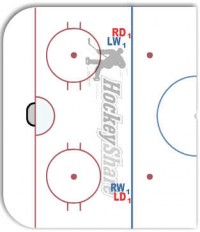 Mano y Mano a No-No
Mano y Mano a No-No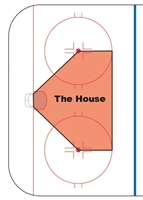 Defend the House
Defend the House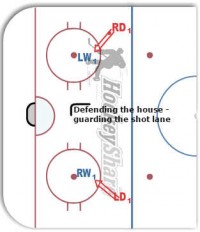 him (your equipment offers the most protection from the front of your body) and skate toward him with your stick extended, blade on the ice. If you do this, chances are he is not going to shoot, as the option won’t look very good to him. And if he does, the most likely scenarios are that the puck goes up off your stick and into the corner or the netting, or better yet off your shin guard and out of the zone. And since you are skating up ice and he is following through on his shot, you’ve got quite a head start on a potential breakaway. The more likely scenario is that he is going to look to pass to one of his teammates. Job well done. If he does this, you can return to your position near the top of the circles.
him (your equipment offers the most protection from the front of your body) and skate toward him with your stick extended, blade on the ice. If you do this, chances are he is not going to shoot, as the option won’t look very good to him. And if he does, the most likely scenarios are that the puck goes up off your stick and into the corner or the netting, or better yet off your shin guard and out of the zone. And since you are skating up ice and he is following through on his shot, you’ve got quite a head start on a potential breakaway. The more likely scenario is that he is going to look to pass to one of his teammates. Job well done. If he does this, you can return to your position near the top of the circles.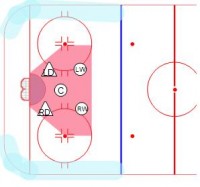 Defend from the Inside Out
Defend from the Inside Out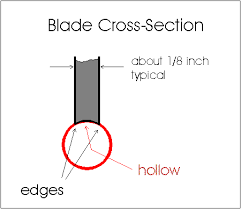 What the heck is blade hollow? And more importantly what does it have to do with the sharpness of my skates? Blade hollow is very important to your skating, yet I am amazed at how few people really understand the concept. And I’m not just talking about newbies to the sport. There are plenty of guys that have been playing their entire lives that don’t understand the concept. In part this is due to the fact that it is counter-intuitive. It also doesn’t help that we (in North America), use fractions (of an inch) rather than decimals (in mm) to measure it. Remind me again why I spent all that time in school learning the metric system? Sorry, I digress. Let’s start with some basic concepts.
What the heck is blade hollow? And more importantly what does it have to do with the sharpness of my skates? Blade hollow is very important to your skating, yet I am amazed at how few people really understand the concept. And I’m not just talking about newbies to the sport. There are plenty of guys that have been playing their entire lives that don’t understand the concept. In part this is due to the fact that it is counter-intuitive. It also doesn’t help that we (in North America), use fractions (of an inch) rather than decimals (in mm) to measure it. Remind me again why I spent all that time in school learning the metric system? Sorry, I digress. Let’s start with some basic concepts.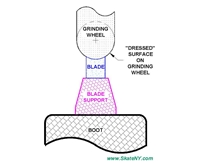 1) The bottom of your blade is not flat, but rather concave. (See blade cross-section figure) This creates a hollow which allows your skate to cut into the ice. If you’ve ever put on a pair of skates out of the box (they don’t come sharpened), you’ve learned this the hard way. No hollow = No bite = Sore butt.
1) The bottom of your blade is not flat, but rather concave. (See blade cross-section figure) This creates a hollow which allows your skate to cut into the ice. If you’ve ever put on a pair of skates out of the box (they don’t come sharpened), you’ve learned this the hard way. No hollow = No bite = Sore butt.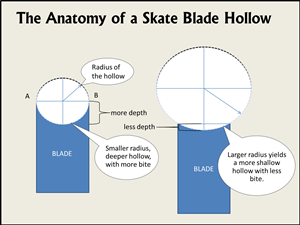 4) OK, now that we are clear on that, you also need to know that the deeper the hollow, the more the skate will bite into the ice. Given two pair of skates that have been freshly sharpened, the skates with the deeper hollow will be sharper. You can actually feel the difference as you run your fingers (carefully and perpendicularly) across the blades.
4) OK, now that we are clear on that, you also need to know that the deeper the hollow, the more the skate will bite into the ice. Given two pair of skates that have been freshly sharpened, the skates with the deeper hollow will be sharper. You can actually feel the difference as you run your fingers (carefully and perpendicularly) across the blades.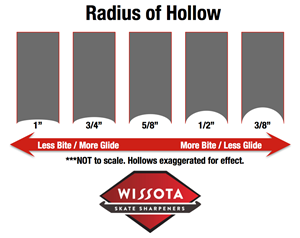 The answer is, it really depends. There are so many variables: How much do you weigh? A lighter player may need a deeper hollow to bite into the ice, whereas that same hollow may produce too much bite for a heavier player. What position do you play? A deeper hollow is better for making quick, sharp turns. But deeper hollows sacrifice glide. Thus, forwards tend to like deeper hollows than defensemen. And goalies generally use very shallow hollows, although even that is changing. How hard is the ice? For hard ice, you want more bite (deeper hollow), but that same hollow may cause too much bite on soft ice. So you may need to change your hollow from rink to rink, and by the season as ice conditions are generally softer in the summer.
The answer is, it really depends. There are so many variables: How much do you weigh? A lighter player may need a deeper hollow to bite into the ice, whereas that same hollow may produce too much bite for a heavier player. What position do you play? A deeper hollow is better for making quick, sharp turns. But deeper hollows sacrifice glide. Thus, forwards tend to like deeper hollows than defensemen. And goalies generally use very shallow hollows, although even that is changing. How hard is the ice? For hard ice, you want more bite (deeper hollow), but that same hollow may cause too much bite on soft ice. So you may need to change your hollow from rink to rink, and by the season as ice conditions are generally softer in the summer.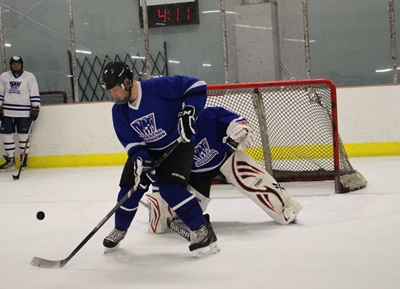 Example 1 – An Effective Screen
Example 1 – An Effective Screen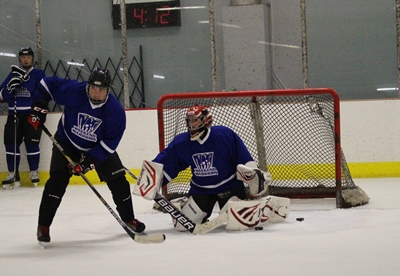 Example 2 – An Ineffective Screen
Example 2 – An Ineffective Screen